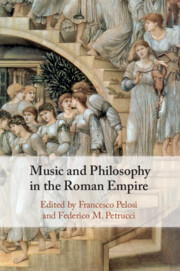Book contents
- Music and Philosophy in the Roman Empire
- Music and Philosophy in the Roman Empire
- Copyright page
- Contents
- Notes on Contributors
- Acknowledgements
- Abbreviations
- Introduction
- Chapter 1 The Scala Naturae and Music
- Chapter 2 Music and Plutarch’s Platonic Cosmos
- Chapter 3 The Harmoniser God
- Chapter 4 Alexander of Aphrodisias and Musical Models for Ontological Enquiries
- Chapter 5 How to Resist Musical Dogmatism
- Chapter 6 Shifting Epistemological Perspectives in Ptolemy’s Harmonics
- Chapter 7 Musical Imagery in Clement of Alexandria and Origen
- Chapter 8 Plotinus on Music, Rhythm, and Harmony
- Chapter 9 Porphyry’s Commentary on Ptolemy’s Harmonics
- Chapter 10 The Music of the Virtues in Late Ancient Platonism
- Chapter 11 Harmonics as Theological Paradigm in Proclus
- Chapter 12 Calcidius on Cosmic Harmony
- Chapter 13 Harmonia in Philoponus’ Commentary on Nicomachus’ Introduction to Arithmetic
- Bibliography
- Index Locorum
- General Index
Chapter 13 - Harmonia in Philoponus’ Commentary on Nicomachus’ Introduction to Arithmetic
Published online by Cambridge University Press: 27 November 2020
- Music and Philosophy in the Roman Empire
- Music and Philosophy in the Roman Empire
- Copyright page
- Contents
- Notes on Contributors
- Acknowledgements
- Abbreviations
- Introduction
- Chapter 1 The Scala Naturae and Music
- Chapter 2 Music and Plutarch’s Platonic Cosmos
- Chapter 3 The Harmoniser God
- Chapter 4 Alexander of Aphrodisias and Musical Models for Ontological Enquiries
- Chapter 5 How to Resist Musical Dogmatism
- Chapter 6 Shifting Epistemological Perspectives in Ptolemy’s Harmonics
- Chapter 7 Musical Imagery in Clement of Alexandria and Origen
- Chapter 8 Plotinus on Music, Rhythm, and Harmony
- Chapter 9 Porphyry’s Commentary on Ptolemy’s Harmonics
- Chapter 10 The Music of the Virtues in Late Ancient Platonism
- Chapter 11 Harmonics as Theological Paradigm in Proclus
- Chapter 12 Calcidius on Cosmic Harmony
- Chapter 13 Harmonia in Philoponus’ Commentary on Nicomachus’ Introduction to Arithmetic
- Bibliography
- Index Locorum
- General Index
Summary
In his commentary on Nicomachus’ Introduction to Arithmetic, John Philoponus explains the role that mathematics, and hence harmonics, play in Platonic philosophy, as redefined by the Neoplatonists. There are two main issues regarding harmonics. The first issue: harmonics is one of the mathematical sciences that lead to the knowledge of divine and absolutely immaterial entities; but harmonics also concerns other mathematical disciplines, because there is an astronomical harmony, that is, the harmony of the revolution of the stars, and there is a geometric harmony, that is, the cube, one of the Platonic solids that are the constitutive elements of the physical world as a geometric model of equality. The second issue: there exists a harmonic proportion, already known to the Pythagoreans, Plato and Aristotle. Both these aspects in Philoponus’ study of harmonics have a common denominator, namely the fact that, as Plato teaches in the Timaeus, the universe, its soul and human souls have a numerical structure based on the relationship between two principles, that is, equality and inequality. But harmonics is precisely the mathematical science of relationship. Therefore, harmonics has a privileged place in the Neoplatonic philosophical system, as Philoponus’ commentary worthily testifies.
- Type
- Chapter
- Information
- Music and Philosophy in the Roman Empire , pp. 286 - 302Publisher: Cambridge University PressPrint publication year: 2020



